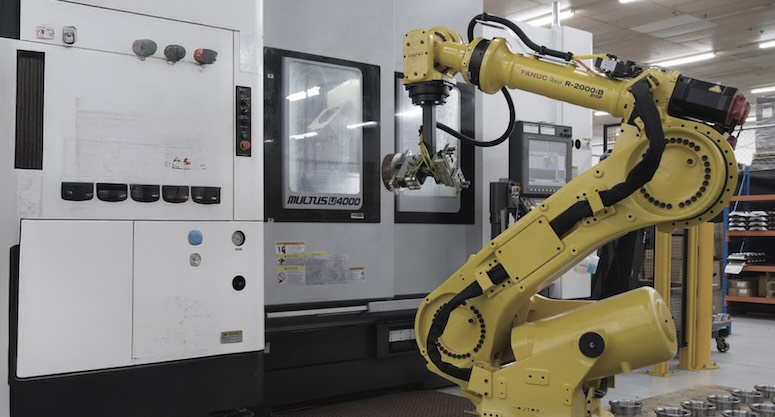
As the United States doubles down on reindustrialization through tariffs, tax policy, and ambitious “Made in USA” initiatives, manufacturers confront an unavoidable reality: reshoring without robotics isn’t just difficult – it’s impossible.
The reindustrialization imperative goes beyond nostalgia and nationalism. It’s about fundamentally transforming American manufacturing into a highly efficient, globally competitive enterprise as Aaron Slodov explains in his Techno-Industrialist Manifesto. This transformation relies on achieving manufacturing scale, speed, and precision that can not be delivered through yesterday’s labor-intensive production methods economically. In short, automation using production robotics is no longer merely advantageous, it has become an economic necessity in this new era.
Are production robots essential for reindustrialization?
The economic logic behind reindustrializing the U.S. is predicated upon overcoming labor-cost disparities that drove offshoring in the first place. While reshoring offers advantages such as better intellectual property protection, shorter supply chains, and reduced geopolitical risks, the lack of workforce skills and higher domestic labor costs pose major barriers.
Production robotics directly address this challenge. Deploying robotic cells at scale on the factory floor for continuous operations increases capacity and dramatically lowers the cost per unit, making U.S.-based manufacturing financially viable.
One of the key, yet particularly challenging, robotic applications that has emerged as essential to scaling volume production is the ability to autonomously load and unload the vast array of different machines in any given factory while ensuring quality. Known as advanced machine tending, the robots must operate with autonomy to coordinate multiple processing steps – including inspection and test – on the full range of parts and products the plant makes.
Including automated inspection and test ensure robotic production output consistently meets specification within tolerance. Precision sensors, vision systems, and automated test equipment work together with robotic production software for autonomous process control. The combination of these capabilities enables robots to detect and prevent defects while creating a digital thread for compliance which is critical in the industries targeted such as aerospace, defense, pharmaceuticals, and semiconductors.
Using robots in this way – directly for the means of production – automates the core operations of the factory to create process flow, productivity and utilization boosting factory throughput and profitability to the levels required for economic viability.
The production robotics chasm
Despite clear economic advantages, successfully implementing robots on the factory floor at the scale required to revitalize America’s manufacturing base presents a substantial challenge. Today’s production robotics landscape is characterized by isolated “islands of automation” with standalone robot installations. If integration is attempted at all, extensive custom software coding is required for each setup.
Due to the nature of these implementations, companies have difficulty getting robots working properly with the machines resulting in coordination issues and downtime. In many cases, businesses simply attempt to operate their robots independently, disconnected from factory machinery and manufacturing IT systems, and experience problems that prevent broad rollouts.
As factories attempt to scale from a handful of robots to dozens or even hundreds, the complexity and costs can spiral due to the custom nature of installations, making true factory-wide robotic automation challenging. At the root of the issue are a myriad of incompatibilities that force a lack of process integration. These disjointed environments and the failures that result, referred to as the “Production Robotics Chasm,” have created a belief by many manufacturing executives that wide scale deployment of robots in production is simply not feasible or financially practical.
The need for a standardized approach
To bridge the production robotics chasm and make scaled automation achievable, U.S. manufacturers need a standardized approach to software-defined control capable of orchestrating robotic systems across entire factories. Standardized software must be powerful, flexible, and designed to connect directly with existing manufacturing IT systems – including ERP (enterprise resource planning), MES (manufacturing execution systems), and others. This type of robotic production software enables the robots to receive specific job instructions for production tasks, part specifications, quality criteria, and real-time adjustments.
Beyond receiving instructions and passing data, standard robotic production software for orchestration must also enable direct robot-to-machine communication for coordinated operation. Robots need to autonomously interact with equipment controllers to manage multiple machines simultaneously, coordinate robot tasks across production lines, and execute complex multi-step robotic processes without human intervention. This capability is essential for achieving “lights-out” production – fully automated, unattended manufacturing operations essential to reshoring economics.
The power of orchestration
With standardized robotic production software solving the interoperability puzzle through open, vendor-agnostic translation, robots from various manufacturers and machinery from diverse suppliers can directly connect and operate together. This dramatically reduces the high costs and long timelines inherent in today’s custom integration projects.
With interoperable orchestration, factories can more rapidly scale their robotic deployments, adding robots and adjusting workflows without fearing custom integration complexity, prolonged downtime, or runaway costs. Standardized orchestration allows manufacturers to adapt quickly, whether it’s ramping up production to meet sudden market demands or rapidly switching products in response to customer changes.
Enabling the AI-Driven Factory
An added benefit of standardized robotic production software extends beyond interoperability alone – it also positions factories to harness the transformative potential of artificial intelligence (AI) to further accelerate the reindustrialization push. The wide range of different AI-powered use cases rapidly emerging – from vision-enabled robot pick-and-place to real-time optimization – can further enhance production throughput, improve quality, and increase operational flexibility.
Factories exploring targeted AI pilots with robots are quickly realizing the need for coordination across the various different use cases from device-based physical AI to robotic process-level agentic AI. Utilizing standardized robotic production software in these cases provides extensive contextual data for faster training along with the broader orchestration layer for operational compliance.
Preparing the human workforce
Of course, robotic automation fundamentally alters the role of human workers. Rather than eliminating jobs outright, automation shifts employment opportunities toward higher-value tasks. Operators who previously performed repetitive manual labor now become multi-robot cell operators and process troubleshooters. Workforce development initiatives, hands-on training programs, and ongoing education at every level are essential to help personnel adapt, ensuring they remain valuable contributors within the reindustrialized landscape.
This workforce transformation represents an enormous opportunity. By investing in workforce upskilling and reskilling initiatives, manufacturers can address labor shortages and build a sustainable talent pipeline capable of fully leveraging the advanced robotics and automation technologies at use in their factories.
The reindustrialization robotics imperative
Reindustrialization in America is no longer simply a political talking point – it’s become an economic and national security imperative. As discussed, however, achieving it hinges upon the widespread and strategic deployment of production robotics. Without robots running the actual means of production, reshored plants simply cannot deliver the cost structures, quality, or productivity necessary for sustained financial competitiveness.
Manufacturers must embrace robotics at scale, invest strategically in automation initiatives, and proactively support workforce transformation. The U.S. factories of tomorrow – the factories reshoring demands – will be fully automated, interconnected, and intelligent. Robots are no longer an incremental efficiency booster; they are foundational infrastructure, essential to America’s industrial revival.

About the Author
Tyler Bouchard is CEO and co-founder of Flexxbotics, a provider of robotic digitalization solutions for robot-driven manufacturing. Prior to starting Flexxbotics, Tyler held senior commercial positions in industrial automation and robotics at Fortune 500 organizations including Cognex, Mitsubishi Electric and Novanta.
Tyler holds a bachelor’s degree in mechanical engineering from Worcester Polytechnic Institute and attended the D’Amore-McKim School of Business at Northeastern University.
The post Reindustrialization won’t work without robotics appeared first on The Robot Report.

